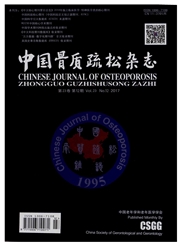

 中文摘要:
中文摘要:
目的建立并评价高血脂骨质疏松症动物模型。方法 3月龄SD雌性大鼠20只,平均随机分成对照组(control,Cont)与高血脂组(hyperlipidemia,HLP)。两组每隔3d分别注射生理盐水(1 m L/10g)和泊洛沙姆407(poloxamer407,P407)(392mg/kg)。12 w后,心脏取血处死并收集血清、胫骨、股骨及腰椎。血清用于血脂生化指标检测;股骨和腰椎用于骨密度、骨生物力学及Micro-CT测定;胫骨用于免疫组织化学及HE染色。结果 HLP组血脂指标(TC、TG、LDL)明显高于Cont组(P〈0.05)。HLP组骨密度与Cont组相比无明显变化,但股骨骨生物力学性能(EL,BRC)明显下降(P〈0.01),骨微结构指数(BV/TV,Conn.D,Tb.Th,Tb.N)低于Cont组(P〈0.01),且骨小梁数量减少,骨组织中BMP2表达下降,PPARγ表达上升。结论P407所致高血脂可有效导致大鼠骨质疏松症。
 英文摘要:
英文摘要:
Objective To establish and evaluate the hyperlipoidemia-induced osteoporosis animal model. Methods Twenty 12-week-old female SD rats were randomly divided into control group( Cont) and hyperlipoidemia group( HLP). Rats were intraperitoneally injected with saline( 1 ml /10 g BW) or P407( 392 mg / kg BW) twice per week. After 12-week administration,the serum was collected for biochemical assays. The femurs and the 5th lumbar vertebrae were dissected for bone mineral density( BMD) determination,bone biomechanical properties test,and trabecular micro-CT analysis. The proximal tibia metaphysic was used for immunohistochemistry and HE staining. Results The serum concentrations of TC,TG,and LDL in HLP group were higher than those in Cont group( P〈 0. 05). Although BMD was constant in both groups,bone biomechanical properties( BRC and EL) of the femur decreased and microarchitecture of the trabecular( BV / TV,Conn. D,Tb. Th,and Tb. N) decreased in HLP group. Immunohistochemistry and HE staining results showed a decrease of BMP2 expression and number of bone trabecular,and an increase of PPARγ expression in HLP group. Conclusion Hyperlipoidemia induced by P407 effectively results in osteoporosis in rats.
 同期刊论文项目
同期刊论文项目
 同项目期刊论文
同项目期刊论文
 期刊信息
期刊信息
